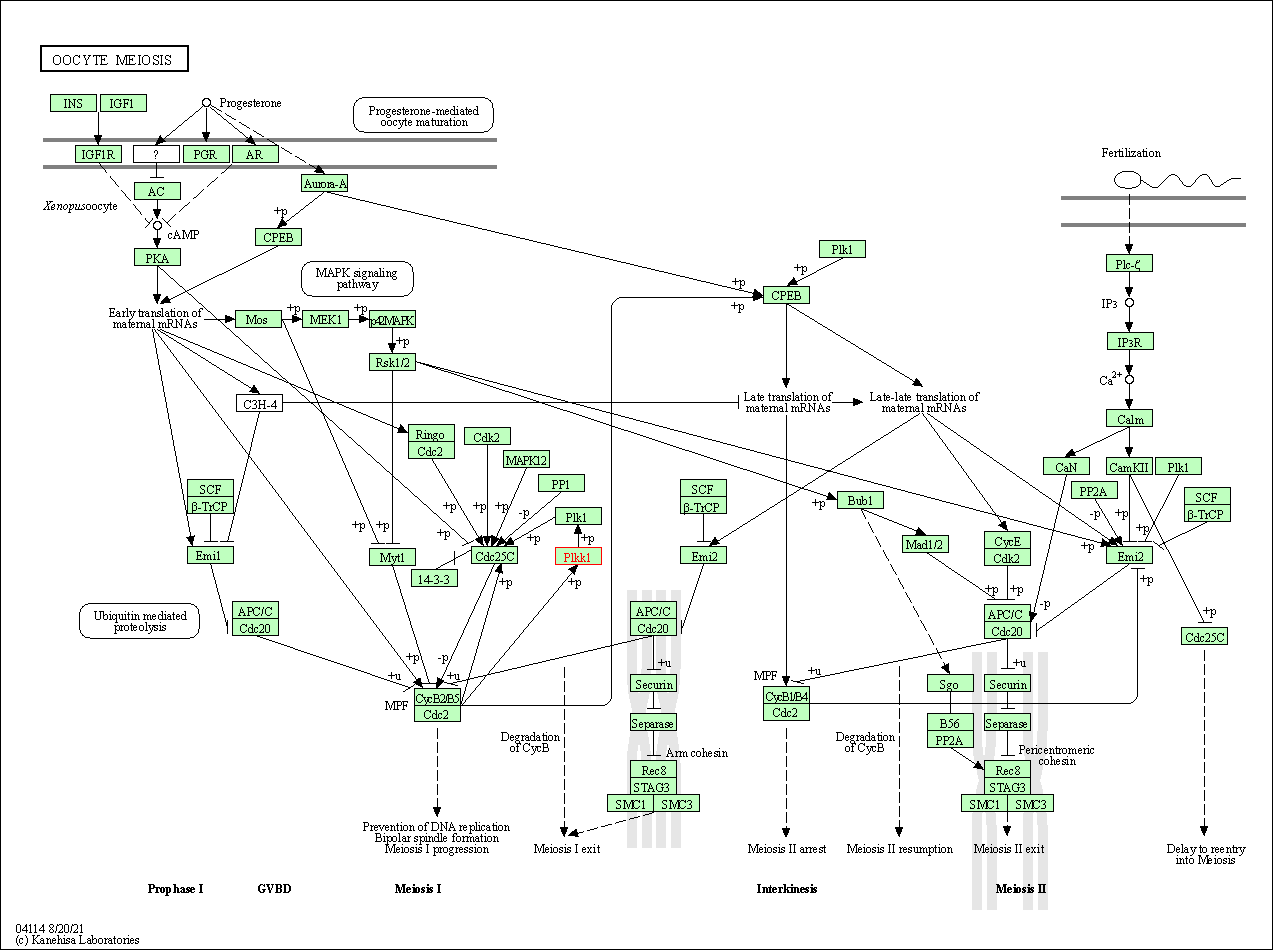Target Information
| Target General Information | Top | |||||
|---|---|---|---|---|---|---|
| Target ID |
T57307
(Former ID: TTDI03000)
|
|||||
| Target Name |
STE20-related serine/threonine-protein kinase (SLK)
|
|||||
| Synonyms |
hSLK; STE20-related kinase; STE20-like kinase
Click to Show/Hide
|
|||||
| Gene Name |
SLK
|
|||||
| Target Type |
Literature-reported target
|
[1] | ||||
| Function |
Mediates apoptosis and actin stress fiber dissolution.
Click to Show/Hide
|
|||||
| UniProt ID | ||||||
| EC Number |
EC 2.7.11.1
|
|||||
| Sequence |
MSFFNFRKIFKLGSEKKKKQYEHVKRDLNPEDFWEIIGELGDGAFGKVYKAQNKETSVLA
AAKVIDTKSEEELEDYMVEIDILASCDHPNIVKLLDAFYYENNLWILIEFCAGGAVDAVM LELERPLTESQIQVVCKQTLDALNYLHDNKIIHRDLKAGNILFTLDGDIKLADFGVSAKN TRTIQRRDSFIGTPYWMAPEVVMCETSKDRPYDYKADVWSLGITLIEMAEIEPPHHELNP MRVLLKIAKSEPPTLAQPSRWSSNFKDFLKKCLEKNVDARWTTSQLLQHPFVTVDSNKPI RELIAEAKAEVTEEVEDGKEEDEEEETENSLPIPASKRASSDLSIASSEEDKLSQNACIL ESVSEKTERSNSEDKLNSKILNEKPTTDEPEKAVEDINEHITDAQLEAMTELHDRTAVIK ENEREKRPKLENLPDTEDQETVDINSVSEGKENNIMITLETNIEHNLKSEEEKDQEKQQM FENKLIKSEEIKDTILQTVDLVSQETGEKEANIQAVDSEVGLTKEDTQEKLGEDDKTQKD VISNTSDVIGTCEAADVAQKVDEDSAEDTQSNDGKEVVEVGQKLINKPMVGPEAGGTKEV PIKEIVEMNEIEEGKNKEQAINSSENIMDINEEPGTTEGEEITESSSTEEMEVRSVVADT DQKALGSEVQDASKVTTQIDKEKKEIPVSIKKEPEVTVVSQPTEPQPVLIPSININSDSG ENKEEIGSLSKTETILPPESENPKENDNDSGTGSTADTSSIDLNLSISSFLSKTKDSGSI SLQETRRQKKTLKKTRKFIVDGVEVSVTTSKIVTDSDSKTEELRFLRRQELRELRFLQKE EQRAQQQLNSKLQQQREQIFRRFEQEMMSKKRQYDQEIENLEKQQKQTIERLEQEHTNRL RDEAKRIKGEQEKELSKFQNMLKNRKKEVINEVEKAPKELRKELMKRRKEELAQSQHAQE QEFVQKQQQELDGSLKKIIQQQKAELANIERECLNNKQQLMRAREAAIWELEERHLQEKH QLLKQQLKDQYFMQRHQLLKRHEKETEQMQRYNQRLIEELKNRQTQERARLPKIQRSEAK TRMAMFKKSLRINSTATPDQDRDKIKQFAAQEEKRQKNERMAQHQKHENQMRDLQLQCEA NVRELHQLQNEKCHLLVEHETQKLKELDEEHSQELKEWREKLRPRKKTLEEEFARKLQEQ EVFFKMTGESECLNPSTQSRISKFYPIPSLHSTGS Click to Show/Hide
|
|||||
| 3D Structure | Click to Show 3D Structure of This Target | AlphaFold | ||||
| Cell-based Target Expression Variations | Top | |||||
|---|---|---|---|---|---|---|
| Cell-based Target Expression Variations | ||||||
| Drug Binding Sites of Target | Top | |||||
|---|---|---|---|---|---|---|
| Ligand Name: Tivozanib | Ligand Info | |||||
| Structure Description | STE20-like serine/threonine-protein kinase (SLK) in complex with Tivozanib | PDB:8BEM | ||||
| Method | X-ray diffraction | Resolution | 2.60 Å | Mutation | No | [2] |
| PDB Sequence |
SMKQYEHVKR
26 DLNPEDFWEI36 IGELGDGGKV48 YKAQNKETSV58 LAAAKVIDTK68 SEEELEDYMV 78 EIDILASCDH88 PNIVKLLDAF98 YYENNLWILI108 EFCAGGAVDA118 VMLELERPLT 128 ESQIQVVCKQ138 TLDALNYLHD148 NKIIHRDLKA158 GNILFTLDGD168 IKLADFGSFI 191 GTPYWMAPEV201 VMCETPYDYK215 ADVWSLGITL225 IEMAEIEPPH235 HELNPMRVLL 245 KIAKSEPPTL255 AQPSRWSSNF265 KDFLKKCLEK275 NVDARWTTSQ285 LLQHPFVTVD 295 SNKPIRELIA305 EAKA
|
|||||
|
|
LEU40
3.725
GLY41
4.305
VAL48
3.639
ALA61
3.113
ALA62
4.700
LYS63
3.734
TYR76
3.900
GLU79
3.361
ILE80
3.347
LEU83
4.108
VAL92
3.995
ILE106
3.983
|
|||||
| Ligand Name: Cdk1/2 inhibitor III | Ligand Info | |||||
| Structure Description | Crystal structure of Human STE20-like kinase bound to 5-Amino-3-((4-(aminosulfonyl)phenyl)amino) -N-(2,6-difluorophenyl)-1H-1,2,4-triazole- 1-carbothioamide | PDB:2J51 | ||||
| Method | X-ray diffraction | Resolution | 2.10 Å | Mutation | No | [3] |
| PDB Sequence |
YEHVTRDLNP
30 EDFWEIIGEL40 GDGAFGKVYK50 AQNKETSVLA60 AAKVIDTKSE70 EELEDYMVEI 80 DILASCDHPN90 IVKLLDAFYY100 ENNLWILIEF110 CAGGAVDAVM120 LELERPLTES 130 QIQVVCKQTL140 DALNYLHDNK150 IIHRDLKAGN160 ILFTLDGDIK170 LADFGVSAKN 180 TRTIQRRDSF190 IGTPYWMAPE200 VVMCETSKDR210 PYDYKADVWS220 LGITLIEMAE 230 IEPPHHELNP240 MRVLLKIAKS250 EPPTLAQPSR260 WSSNFKDFLK270 KCLEKNVDAR 280 WTTSQLLQHP290 FVTVDSNKPI300 RELIAEAK
|
|||||
|
|
||||||
| Click to View More Binding Site Information of This Target and Ligand Pair | ||||||
| Click to View More Binding Site Information of This Target with Different Ligands | ||||||
| Different Human System Profiles of Target | Top |
|---|---|
|
Human Similarity Proteins
of target is determined by comparing the sequence similarity of all human proteins with the target based on BLAST. The similarity proteins for a target are defined as the proteins with E-value < 0.005 and outside the protein families of the target.
A target that has fewer human similarity proteins outside its family is commonly regarded to possess a greater capacity to avoid undesired interactions and thus increase the possibility of finding successful drugs
(Brief Bioinform, 21: 649-662, 2020).
Human Tissue Distribution
of target is determined from a proteomics study that quantified more than 12,000 genes across 32 normal human tissues. Tissue Specificity (TS) score was used to define the enrichment of target across tissues.
The distribution of targets among different tissues or organs need to be taken into consideration when assessing the target druggability, as it is generally accepted that the wider the target distribution, the greater the concern over potential adverse effects
(Nat Rev Drug Discov, 20: 64-81, 2021).
Human Pathway Affiliation
of target is determined by the life-essential pathways provided on KEGG database. The target-affiliated pathways were defined based on the following two criteria (a) the pathways of the studied target should be life-essential for both healthy individuals and patients, and (b) the studied target should occupy an upstream position in the pathways and therefore had the ability to regulate biological function.
Targets involved in a fewer pathways have greater likelihood to be successfully developed, while those associated with more human pathways increase the chance of undesirable interferences with other human processes
(Pharmacol Rev, 58: 259-279, 2006).
Human Similarity Proteins
Human Tissue Distribution
Human Pathway Affiliation
|
|
|
Note:
If a protein has TS (tissue specficity) scores at least in one tissue >= 2.5, this protein is called tissue-enriched (including tissue-enriched-but-not-specific and tissue-specific). In the plots, the vertical lines are at thresholds 2.5 and 4.
|
| KEGG Pathway | Pathway ID | Affiliated Target | Pathway Map |
|---|---|---|---|
| Oocyte meiosis | hsa04114 | Affiliated Target |

|
| Class: Cellular Processes => Cell growth and death | Pathway Hierarchy | ||
| Chemical Structure based Activity Landscape of Target | Top |
|---|---|
| References | Top | |||||
|---|---|---|---|---|---|---|
| REF 1 | RN486, a selective Bruton's tyrosine kinase inhibitor, abrogates immune hypersensitivity responses and arthritis in rodents. J Pharmacol Exp Ther. 2012 Apr;341(1):90-103. | |||||
| REF 2 | STE20-like serine/threonine-protein kinase (SLK) in complex with Tivozanib | |||||
| REF 3 | Activation segment dimerization: a mechanism for kinase autophosphorylation of non-consensus sites. EMBO J. 2008 Feb 20;27(4):704-14. | |||||
If You Find Any Error in Data or Bug in Web Service, Please Kindly Report It to Dr. Zhou and Dr. Zhang.

